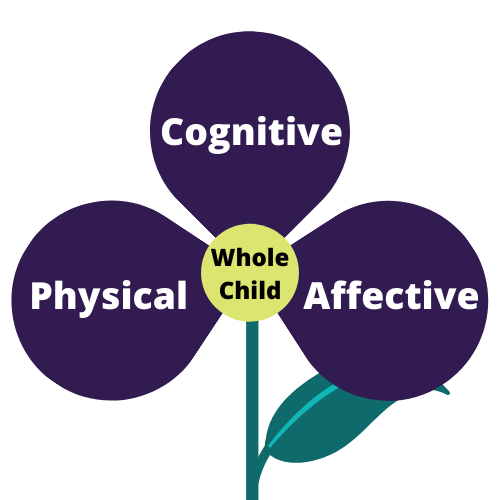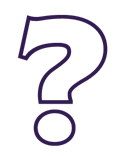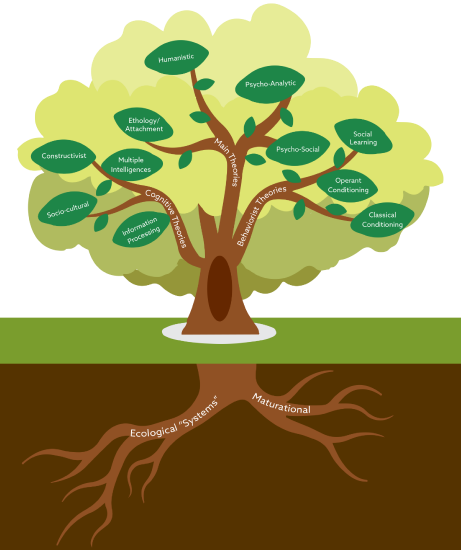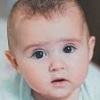As with the historical perspectives that were discussed in Chapter 1, theories provide varied and in-depth perspectives that can be used to explain the complexity of human development.
Human development is divided into 3 main areas: Physical, Cognitive, and Affective. Together these address the development of the whole child.
Physical-motor development – this includes our gross motor, fine motor, and perceptual-motor. [5]
Cognitive or intellectual development – this includes our thoughts and how our brain processes information, as well as utilizes language so that we can communicate with one another. [6]
Affective development – this includes our emotions, social interactions, personality, creativity, spirituality, and the relationships we have with ourselves and others. [7]
All three areas of development are of critical importance in how we support the whole child. For example, if we are more concerned about a child’s cognitive functioning we may neglect to give attention to their affective development. We know that when a child feels good about themselves and their capabilities, they are often able to take the required risks to learn about something new to them. Likewise, if a child is able to use their body to learn, that experience helps to elevate it to their brain.
 |
Quotable
“If it isn’t in the body, it can’t be in the brain.”
- Bev Boss
|
 |
Quotable
“Students who are loved at home come to school to learn, and students who aren’t, come to school to be loved.”
- Nicholas A. Ferroni
|

Figure \(\PageIndex{1}\): Whole Child Flower. [8]
Theories help us to understand behaviors and recognize developmental milestones so that we can organize our thoughts and consider how to best support a child’s individual needs. With this information, we can then plan and implement learning experiences that are appropriate for the development of that child (called, “developmentally appropriate practice, which is discussed more later in this chapter), set up engaging environments, and most importantly, we can develop realistic expectations based on the child’s age and stage of development.
A theory is defined as “a supposition, or a system of ideas intended to explain something, especially one based on general principles independent of the thing to be explained, a set of principles on which the practice of an activity is based.” [9]
The theories we chose to include in this text form the underlying “principles” that guide us in the decisions we make about the children in our care, as well as provide us with insight on how to best support children as they learn, grow, and develop. The theories that have been selected were proposed by scientists and theorists who studied human development extensively. Each, with their own unique hypothesis, set out to examine and explain development by collecting data through observations/experiments. The theorists we selected, strived to answer pertinent questions about how we develop and become who we are. Some sought to explain why we do what we do, while others studied when we should achieve certain skills. Here are a few of the questions developmental theorists have considered:
- Is development due to maturation or due to experience? This is often described as the nature versus nurture debate. Theorists who side with nature propose that development stems from innate genetics or heredity. It is believed that as soon as we are conceived, we are wired with certain dispositions and characteristics that dictate our growth and development. Theorists who side with nurture claim that it is the physical and temporal experiences or environment that shape and influence our development. It is thought that our environment -our socio-economic status, the neighborhood we grow up in, and the schools we attend, along with our parents’ values and religious upbringing impact our growth and development. Many experts feel it is no longer an “either nature OR nurture” debate but rather a matter of degree; which influences development more?
- Does one develop gradually or does one undergo specific changes during distinct time frames? This is considered the continuous or discontinuous debate. On one hand, some theorists propose that growth and development are continuous; it is a slow and gradual transition that occurs over time, much like an acorn growing into a giant oak tree. While on the other hand, there are theorists that consider growth and development to be discontinuous; which suggests that we become different organisms altogether as we transition from one stage of development to another, similar to a caterpillar turning into a butterfly.
 |
Pause to Reflect… Personal Growth and Development
Think about your own growth and development.
- Do you favor one side of the nature vs nurture debate?
- Which premise seems to make more sense – continuous or discontinuous development?
Take a moment to jot down some ideas. Your ideas help to create opportunities to deepen our understanding and to frame our important work with young children and their families.?
|
As suggested earlier, not only do theories help to explain key components of human development, theories also provide practitioners with valuable insight that can be utilized to support a child’s learning, growth, and development. At this time, we would like to mention that although theories are based on notable scientific discoveries, it is necessary to emphasize the following:
- No one theory exclusively explains everything about a child’s development.
- Theories are designed to help us make educated guesses about children’s development
- Each theory focuses on a different aspect of human development
- Theories often build on previous theoretical concepts and may seek to expand ideals or explore new facets.
Let’s take a look at the theories:

Figure \(\PageIndex{2}\): The Theory Tree. [10]
We are going to break it up as follows:
Table \(\PageIndex{1}\): Roots - Foundational Theories [11]
| Theory |
Key Points |
Application |
|
Maturational
Arnold Gesell
1880 - 1961
|
- All children move through stages as they grow and mature
- On average, most children of the same age are in the same stage
- There are stages in all areas of development (physical, cognitive, language, affective)
- You can’t rush stages
|
- There are “typical” ages and stages
- Understand current stage as well as what comes before and after
- Give many experiences that meet the children at their current stage of development
- When child is ready they move to the next stage
|
|
Ecological “Systems”
Urie Bronfenbrenner
1917 – 2005
|
- There is broad outside influence on development
- (Family, school, community, culture, friends ….)
- There “environmental” influences impact development significantly
|
- Be aware of all systems that affect child
- Learning environment have impact on the developing child
- Home, school, community are important
- Supporting families supports children
|
This content was created by Sharon Eyrich. It is used with permission and should not be altered.
Table \(\PageIndex{2}\): Branches – Topical Theories [12]
| Theory |
Key Points |
Application |
|
Psycho-Analytic
Sigmund Freud
1856 – 1939
|
- Father of Psychology
- Medical doctor trying to heal illness
- We have an unconscious
- Early experiences guide later behavior
- Young children seek pleasure (id)
- Ego is visible; when wounded can get defensive
- Early stages of development are critical to healthy development
|
- Understand unconscious motivations
- Create happy and healthy early experiences for later life behaviors
- Know children are all about “ME”
- Expect ego defenses
- Keep small items out of toddlers reach
- Treat toileting lightly
|
|
Psycho-Social
Erik Erikson
1902 – 1994
|
- Relationships are crucial and form the social context of personality
- Early experiences shape our later relationships and sense of self
- Trust, autonomy, initiative – are the early stages of development
- Humans like to feel competent and valued
|
- Provide basic trust (follow through on promises, provide stability and consistency, …)
- Create a sense of “belongingness”
- Support autonomy and exploration
- Help children feel confident
- Encourage trying things and taking safe risks
- See mistakes as learning opportunities
|
|
Humanistic
Abraham Maslow
1908-1970
|
- We have basic and growth needs
- Basic needs must be met first
- We move up the pyramid toward self-actualization
|
- Make sure basic needs like nutrition, sleep, safety is taken care of
- Understand movement between needs
- Know needs may be individual or as a group
|
|
Ethology/Attachment
John Bowlby
1907-1990
Mary Ainsworth
1913 - 1999
|
- Biological basis for development
- Serve evolutionary function for humankind
- There are sensitive periods
- Attachment is crucial for survival
- Dominance hierarchies can serve survival function
|
- Understand evolutionary functions
- Offer positive and appropriate opportunities doing sensitive periods
- Facilitate healthy attachments
|
This content was created by Sharon Eyrich. It is used with permission and should not be altered.
Table \(\PageIndex{3}\): Branches – Cognitive Theories [13]
|
Theory
|
Key Points
|
Application
|
|
Constructivist
Jean Piaget
1896 – 1980
|
- We construct knowledge from within
- Active learning and exploration
- Brains organize and adapt
- Need time and repetition
- Distinct stages (not mini-adults)
- Sensory-motor, pre-operational
|
- Provide exploration and active learning
- Ask open ended questions/promote thinking
- Repeat often
- Don’t rush
- Allow large blocks of time
- Value each unique stage
- Provide sensory and motor experiences
- Provide problem solving experience
|
|
Socio-cultural
Lev Vygotsky
1896 – 1934
|
- Learning occurs within a social context
- Scaffolding – providing appropriate support to increase learning
- “Zone of proximal development” = “readiness to learn” something
|
- Provide appropriate adult-child interactions
- Encourage peer interactions
- Provide a little help, then step back
- Understand when a child is ready; don’t push them or do it for them
|
|
Information Processing
(Computational Theory)
1970 -
|
- Brain is like a computer
- Input, process, store, retrieve
- Early experiences create learning pathways
- Cortisol – stress hormone shuts down thinking
- Endorphins – “happy” hormone, increases learning
|
- Develop healthy brains (nutrition, sleep, exercise)
- Decrease stress, increase happiness
- Know sensory input (visual, auditory ….)
- Understand individual differences
- Allow time to process
|
|
Multiple Intelligences
Howard Gardner
1943 -
|
- Once information enters the brain, each brain processes information differently
|
- Provide learning experiences to meet a wide range of learning styles
- Help learners learn how they learn best
- Offer many experiences in a variety of ways
|
This content was created by Sharon Eyrich. It is used with permission and should not be altered.
Table \(\PageIndex{4}\): Branches – Behaviorist Theories
|
Theory
|
Key Points
|
Application
|
|
Classical Conditioning
Ivan Pavlov
1849 - 1936
|
- We respond automatically to some stimuli
- When we pair a neutral stimulus with the one that elicits a response we can train the subject to respond to it
- Over time we can “un-pair” stimulus and response
|
- Be aware of conditioning
- Pair stimuli to elicit desired responses
- Look for pairings in undesirable behaviors
|
|
Operant Conditioning
B. F. Skinner
1904 – 1990
|
- Behavior is related to consequences
- Reinforcement/Rewards/Punishment
- Goals of behavior (motivators)
|
- Understand what is motivating behavior
- Reinforce behavior we want
- Don’t reinforce behavior we don’t want
- Consider small increments
|
|
Social Learning
Albert Bandura
1925 -
|
- Children (and adults) learn through observation
- Children (and adults) model what they see
|
- Know what children are watching
- Model what you want children to do
|
This content was created by Sharon Eyrich. It is used with permission and should not be altered.







